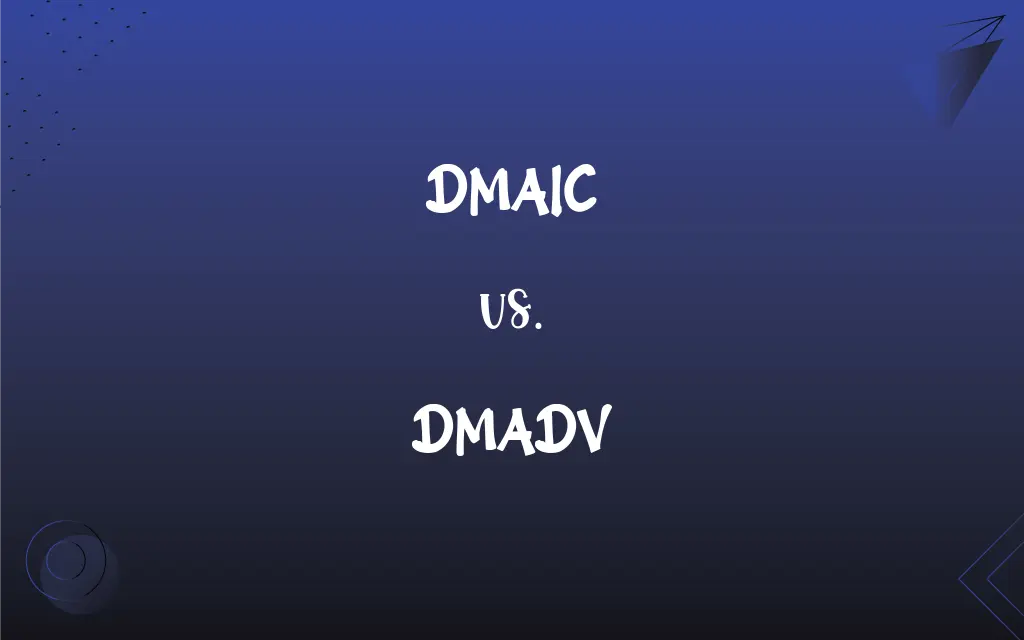DMAIC vs. DMADV: What's the Difference?
Edited by Aimie Carlson || By Janet White || Published on February 18, 2024
DMAIC focuses on improving existing processes, while DMADV is used for creating new processes or products.

Key Differences
DMAIC and DMADV are both methodologies used in Six Sigma for improving processes, but they serve different purposes.
DMAIC stands for Define, Measure, Analyze, Improve, and Control. It's a data-driven improvement cycle used for enhancing, optimizing, and stabilizing existing business processes and designs. DMAIC is most beneficial when a process is in existence but not performing to the required standard or specifications. The focus is on making incremental improvements to existing processes, which might be underperforming or inefficient.
DMADV, on the other hand, stands for Define, Measure, Analyze, Design, and Verify. This methodology is used primarily when creating new product designs or process designs from scratch. DMADV is applied when the existing process is not sufficient and needs a complete overhaul, or when a new process is needed due to the introduction of new technology or new business need. It emphasizes designing to meet customer needs and process performance.
DMAIC is focused on refining and enhancing current processes, while DMADV is used to develop new processes or products at Six Sigma quality levels. DMAIC aims at small, incremental improvements, whereas DMADV focuses on radical changes through innovative solutions.
Both DMAIC and DMADV are integral to Six Sigma methodology, but their application depends on the specific needs of the business process. DMAIC is best suited for existing processes that need tweaking, whereas DMADV is the go-to for creating entirely new processes or making substantial changes to existing ones.
ADVERTISEMENT
Comparison Chart
Purpose
Improve existing processes
Design new processes/products
Focus
Incremental improvements
Innovation and major changes
Applicability
Existing processes
New or significantly revised processes
Methodology
Define, Measure, Analyze, Improve, Control
Define, Measure, Analyze, Design, Verify
Outcome
Process enhancement
New process or product creation
ADVERTISEMENT
DMAIC and DMADV Definitions
DMAIC
A method to improve efficiency and effectiveness of existing processes.
The DMAIC cycle helped us reduce waste in our manufacturing process.
DMADV
A process used for significant overhaul or creation of business processes.
Implementing DMADV, we designed a completely new logistics strategy.
DMAIC
A structured problem-solving methodology in Six Sigma.
Our team implemented DMAIC to enhance the quality of our customer service.
DMADV
A framework for designing processes to meet Six Sigma standards.
DMADV guided us in developing a zero-defect manufacturing process.
DMAIC
A framework used to optimize business processes and performance.
Through DMAIC, we improved our order fulfillment time by 30%.
DMADV
A Six Sigma methodology used for creating new processes or products.
We utilized DMADV to design our innovative customer feedback system.
DMAIC
A process improvement tool focusing on quality management.
DMAIC was essential in achieving a significant reduction in operational errors.
DMADV
A structured approach for developing new business strategies.
Our new product launch was successful thanks to the DMADV process.
DMAIC
A systematic, data-driven approach for process improvement.
Using DMAIC, we identified and eliminated the bottlenecks in our production line.
DMADV
A method for designing innovative solutions that satisfy customer needs.
The DMADV approach led to a breakthrough in our software development process.
FAQs
What is the main purpose of DMAIC?
DMAIC is used for improving and optimizing existing processes.
Can DMAIC be used for new processes?
No, DMAIC is best suited for existing processes that need improvements.
How does DMAIC ensure process improvement?
DMAIC uses a data-driven approach to identify and address process inefficiencies.
Is DMAIC part of Six Sigma?
Yes, DMAIC is a key component of Six Sigma methodology.
When is DMADV used?
DMADV is used for designing new processes or products.
Can DMADV replace an existing process?
Yes, DMADV can be used to overhaul or completely replace existing processes.
Can DMADV be used for existing product improvement?
DMADV is generally used for new designs, not for improving existing ones.
Is DMADV similar to DMAIC?
While similar in structure, DMADV focuses on design and creation, unlike DMAIC.
What does DMAIC stand for?
DMAIC stands for Define, Measure, Analyze, Improve, and Control.
Are DMAIC and DMADV interchangeable?
No, they serve different purposes and are not interchangeable.
How does DMADV ensure quality in new designs?
DMADV focuses on meeting customer needs and achieving Six Sigma quality levels.
Does DMADV focus on customer requirements?
Yes, understanding and fulfilling customer requirements is a key aspect of DMADV.
What does DMADV stand for?
DMADV stands for Define, Measure, Analyze, Design, and Verify.
Does DMAIC require statistical analysis?
Yes, DMAIC often involves statistical analysis to identify and solve problems.
What is the first step in the DMAIC process?
The first step in DMAIC is 'Define,' where the problem and scope are identified.
What is the final phase of DMADV?
The final phase of DMADV is 'Verify,' which ensures the design meets specifications.
Which is more suitable for a small process tweak, DMAIC or DMADV?
DMAIC is more suitable for small, incremental process improvements.
Is training required to implement DMADV?
Yes, understanding Six Sigma and DMADV principles is essential for implementation.
Can DMAIC lead to cost savings?
Yes, DMAIC can lead to significant cost savings by improving process efficiency.
How do DMAIC and DMADV contribute to business success?
Both methodologies aim to improve business processes, DMAIC by refining existing processes and DMADV by innovating new ones, contributing to overall business success.
About Author
Written by
Janet WhiteJanet White has been an esteemed writer and blogger for Difference Wiki. Holding a Master's degree in Science and Medical Journalism from the prestigious Boston University, she has consistently demonstrated her expertise and passion for her field. When she's not immersed in her work, Janet relishes her time exercising, delving into a good book, and cherishing moments with friends and family.
Edited by
Aimie CarlsonAimie Carlson, holding a master's degree in English literature, is a fervent English language enthusiast. She lends her writing talents to Difference Wiki, a prominent website that specializes in comparisons, offering readers insightful analyses that both captivate and inform.































































